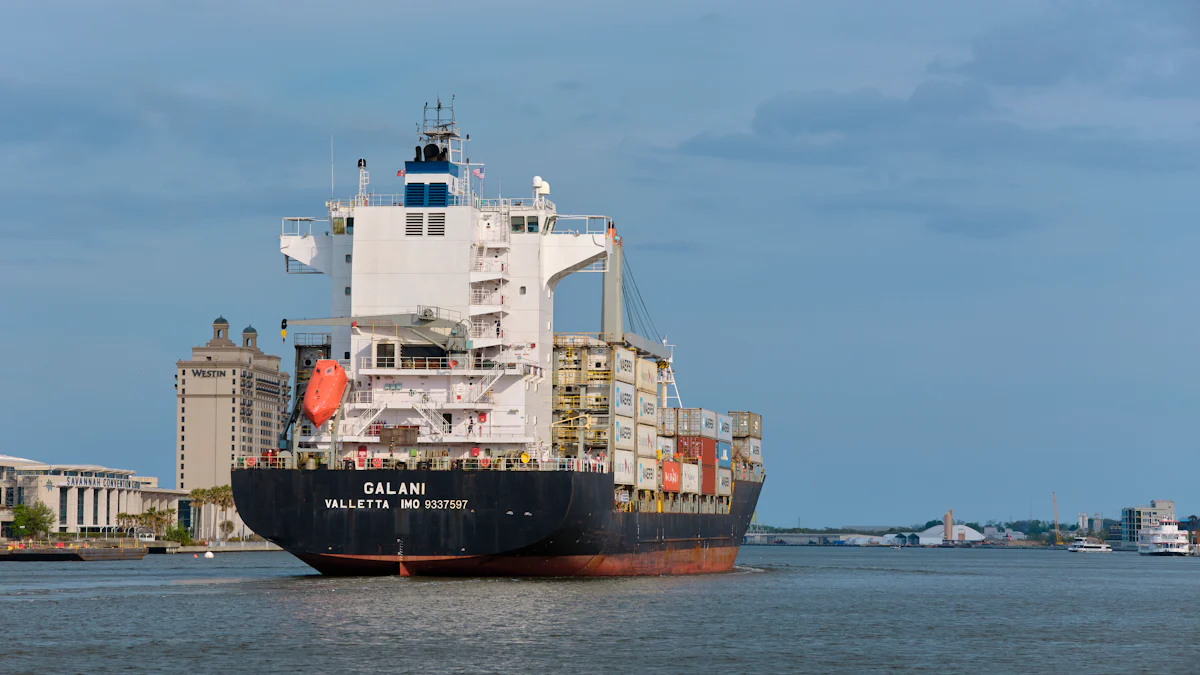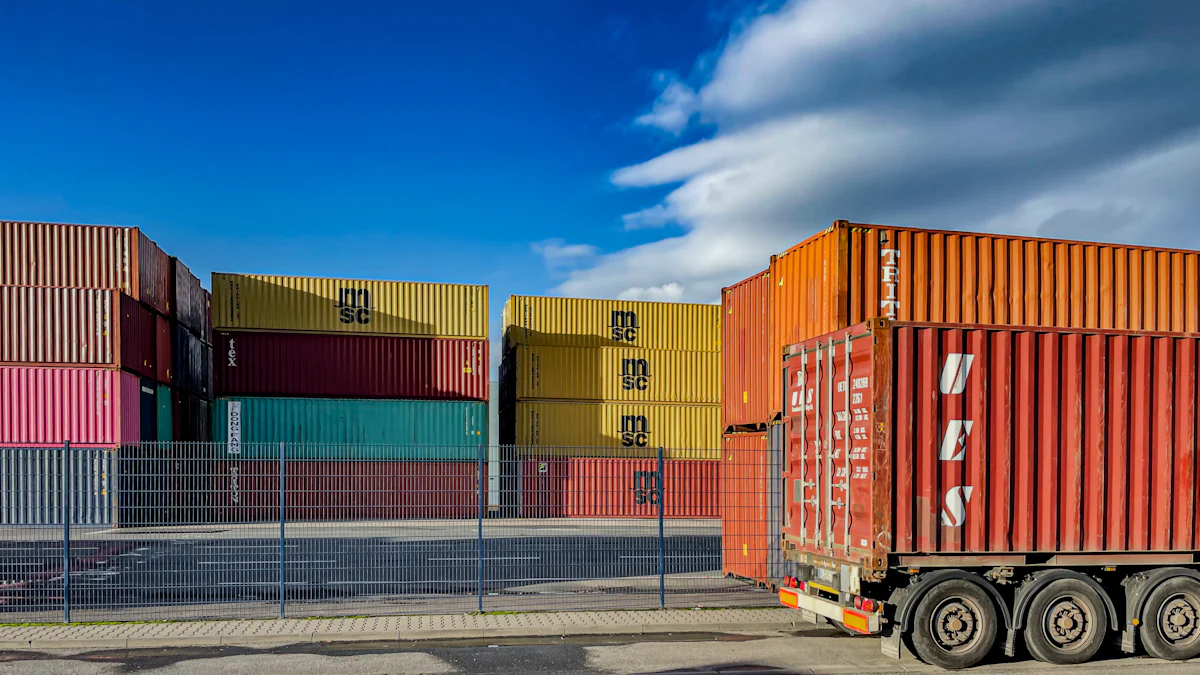How Ocean Freight Visibility Drives Better Logistics Decisions

Ocean freight visibility transforms how businesses manage their logistics. By providing real-time monitoring of cargo, it empowers companies to make informed decisions that enhance operational efficiency. Freight visibility tools reduce manual processes and improve shipment tracking accuracy, ensuring seamless transportation. Solutions like JusLink leverage advanced technologies such as IoT and big data to deliver real-time insights, enabling proactive risk management. With accurate tracking notifications and predictive analytics, businesses optimize delivery schedules, reduce costs, and elevate customer satisfaction. The visibility benefits extend across the supply chain, making logistics visibility a cornerstone of modern ocean freight services.
What is Ocean Freight Visibility?

Ocean freight visibility has become a cornerstone of modern logistics, transforming how businesses manage their supply chains. It refers to the ability to monitor and track cargo throughout its journey across the ocean, providing stakeholders with real-time insights into the location, condition, and progress of shipments. This capability empowers companies to make informed decisions, minimize disruptions, and optimize operations.
Definition and Overview
Ocean freight visibility encompasses the tools and technologies that enable businesses to gain a clear view of their cargo's movement from origin to destination. By integrating advanced platforms, companies can achieve end-to-end tracking, ensuring transparency at every stage of the shipping process. This visibility is not limited to location data; it also includes predictive insights, such as accurate ETAs, and automated alerts for potential disruptions. The growing demand for ocean shipment visibility stems from the increasing complexity of global trade and the need for seamless logistics management.
"Over 90% of global trade relies on ocean freight, making visibility solutions essential for efficient supply chain management."
The adoption of freight visibility tools has surged in recent years, driven by the tumultuous challenges faced by the shipping industry. These tools provide businesses with the ability to monitor shipments in real time, reducing inefficiencies and enabling proactive responses to potential delays. As a result, ocean freight visibility has become a critical component of global logistics strategies.
Key Components of Ocean Freight Visibility
Real-Time Tracking
Real-time tracking forms the foundation of ocean freight visibility. It allows businesses to monitor the precise location of their cargo at any given moment. This capability eliminates the guesswork associated with traditional shipping methods and provides stakeholders with actionable data. Real-time tracking ensures that companies can identify potential bottlenecks, reroute shipments if necessary, and maintain operational efficiency.
For example, platforms like JusLink leverage IoT devices to provide continuous updates on container movements. These updates enable businesses to stay informed about their shipments' progress and make adjustments to their logistics plans as needed.
Predictive ETAs (Estimated Time of Arrival)
Predictive ETAs enhance the value of ocean shipment visibility by offering accurate arrival forecasts. These predictions rely on advanced algorithms and data analytics to account for variables such as weather conditions, port congestion, and vessel speed. Accurate ETAs help businesses plan their inventory management, reduce unnecessary costs, and improve customer satisfaction.
By utilizing optimized ocean shipment visibility solutions, companies can align their operations with these predictions, ensuring that resources are allocated efficiently. Predictive ETAs also play a crucial role in minimizing disruptions, as they provide early warnings of potential delays.
Exception Management and Alerts
Exception management and alerts are vital for maintaining smooth logistics operations. These features notify stakeholders of any deviations from the planned shipping schedule, such as delays, route changes, or damaged cargo. Automated alerts enable businesses to respond swiftly to unexpected events, mitigating risks and avoiding costly disruptions.
Real-time visibility tools equipped with exception management capabilities empower companies to take proactive measures. For instance, if a shipment faces delays due to port congestion, the system can suggest alternative routes or adjust delivery schedules to minimize impact.
Why is Ocean Freight Visibility Important?
Ocean freight visibility plays a pivotal role in modern logistics. It empowers businesses to streamline operations, minimize disruptions, and enhance customer experiences. By leveraging real-time insights, companies can transform their supply chain management strategies and achieve operational excellence.
Optimizing Supply Chain Operations
Freight visibility enables businesses to optimize their supply chain operations by providing real-time data on cargo movements. This transparency allows supply chain managers to monitor shipments at every stage, ensuring efficient resource allocation and reducing inefficiencies.
For instance, real-time tracking tools help identify potential bottlenecks in transportation routes. Companies can then adjust their logistics plans to avoid delays and maintain smooth operations. With shipment visibility, businesses gain the ability to make proactive decisions, improving overall supply chain performance.
"Without ocean freight visibility, supply chain managers often rely on outdated information, leading to missed opportunities for optimization and increased operational costs."
The integration of advanced freight visibility solutions ensures that businesses can align their operations with precise delivery schedules. This alignment reduces unnecessary expenses, such as expedited shipping fees, and enhances inventory management.
Reducing Delays and Disruptions
Delays and disruptions in ocean freight services can significantly impact business operations. Freight visibility tools mitigate these risks by offering real-time updates and exception alerts. These features enable companies to respond swiftly to unforeseen events, such as port congestion or adverse weather conditions.
Real-time tracking provides accurate ETAs, allowing businesses to anticipate delays and adjust their plans accordingly. For example, if a shipment faces unexpected delays, companies can reroute cargo or reschedule deliveries to minimize the impact on their supply chain.
The visibility benefits extend beyond immediate problem-solving. By analyzing historical tracking data, businesses can identify recurring issues and implement long-term solutions to prevent future disruptions. This proactive approach enhances the reliability of logistics operations.
Enhancing Customer Satisfaction and Transparency
In today’s competitive market, customer satisfaction hinges on transparency and reliability. Ocean freight visibility fosters trust by providing customers with real-time updates on their shipments. Accurate shipment tracking ensures that customers remain informed about the status of their orders, improving their overall experience.
Transparency also strengthens relationships between businesses and their clients. When companies share real-time shipment visibility data, they demonstrate accountability and commitment to service excellence. This level of transparency not only builds trust but also sets businesses apart in the crowded logistics industry.
Moreover, precise delivery timelines enabled by freight visibility tools reduce the likelihood of missed deadlines. Customers receive their orders on time, leading to higher satisfaction rates and repeat business. Logistics visibility, therefore, becomes a key driver of customer loyalty and competitive advantage.
How Ocean Freight Visibility Drives Better Decisions
Improving Inventory Management
Ocean freight visibility enhances inventory management by providing real-time insights into cargo movements. Businesses gain the ability to monitor shipment tracking, ensuring accurate updates on the status and location of goods. This level of transparency allows companies to align inventory levels with demand, reducing overstocking and stockouts. Real-time data empowers supply chain managers to make informed decisions about replenishment schedules, minimizing unnecessary storage costs.
Enhanced shipment tracking also improves credit cycles by ensuring timely delivery of goods. Companies can maintain better cash flow by reducing delays in inventory turnover. For example, visibility platforms equipped with predictive analytics help businesses anticipate potential disruptions, enabling them to adjust procurement plans proactively. This optimization not only reduces costs but also supports sustainability goals by minimizing waste and excess inventory.
"Full visibility improves inventory control, reduces credit cycles, and aids in sustainability goal achievement." – FourKites
By leveraging advanced freight visibility tools, businesses can achieve greater command over their inventory, ensuring that resources are allocated efficiently across the supply chain.
Enabling Route Optimization
Freight visibility plays a critical role in optimizing transportation routes. Real-time tracking provides valuable insights into the most efficient paths for cargo movement, helping businesses avoid delays caused by port congestion or adverse weather conditions. This proactive approach reduces transit times and ensures timely delivery of goods.
Visibility benefits extend to cost savings as well. By analyzing historical shipment tracking data, companies can identify patterns and implement strategies to streamline their logistics operations. For instance, predictive ETAs allow businesses to plan routes that minimize fuel consumption and reduce overall transportation expenses. This level of precision enhances the reliability of ocean freight services, ensuring that shipments reach their destinations without unnecessary detours.
"Real-time tracking provides valuable insights for smarter decisions, route optimization, and loss mitigation." – Windward
Platforms like JusLink utilize IoT devices and big data analytics to deliver actionable insights, enabling businesses to refine their logistics strategies. These tools ensure that supply chain visibility translates into tangible improvements in operational efficiency.
Proactive Risk Management and Contingency Planning
Ocean freight visibility equips businesses with the tools needed for proactive risk management. Real-time updates and exception alerts enable companies to identify potential disruptions before they escalate. For example, if a shipment faces delays due to unforeseen circumstances, visibility platforms can suggest alternative routes or adjust delivery schedules to mitigate the impact.
"Visibility technology is crucial for monitoring critical events and disruptions in the supply chain." – DB Schenker
Proactive measures reduce penalties and costs associated with delayed shipments. By leveraging enhanced shipment tracking, businesses can predict delays and take corrective actions promptly. This capability ensures that logistics operations remain resilient, even in the face of challenges such as port strikes or natural disasters.
Visibility benefits also include improved contingency planning. Historical data from freight visibility tools helps businesses identify recurring issues and develop strategies to prevent future disruptions. This continuous improvement cycle strengthens supply chain management, ensuring that companies can navigate the complexities of global trade with confidence.
"Visibility platforms help identify potential disruptions, plan ahead, and decrease fines and costs in ocean supply chains." – The Loadstar
By integrating logistics visibility solutions, businesses can enhance their ability to respond to risks, optimize resource allocation, and maintain seamless operations across their supply chains.
Technologies Enabling Ocean Freight Visibility

Modern logistics relies on advanced technologies to achieve seamless ocean freight visibility. These tools empower businesses with real-time insights, enabling them to optimize operations, reduce costs, and enhance customer satisfaction. The following technologies play a pivotal role in transforming transportation visibility into a strategic advantage.
Internet of Things (IoT) Devices
IoT devices revolutionize freight visibility by providing continuous monitoring of cargo throughout its journey. Sensors embedded in containers track critical parameters such as location, temperature, humidity, and vibration. This data ensures that businesses maintain control over shipment conditions and respond promptly to anomalies.
For instance, IoT-enabled platforms like JusLink integrate sensor data to deliver real-time updates on container movements. These updates allow companies to anticipate delays, reroute shipments, and safeguard perishable goods. By leveraging IoT technology, businesses enhance shipment tracking accuracy and improve overall supply chain resilience.

SMART JusLink
Supply Chain Management Solution
"IoT sensors provide unparalleled visibility benefits by offering real-time monitoring of cargo conditions and locations." – SeaVantage
The ability to monitor shipments in real time reduces risks associated with damaged goods and missed deadlines. IoT devices also support predictive maintenance by identifying potential equipment failures, ensuring uninterrupted ocean freight services.
Application Programming Interfaces (APIs)
APIs streamline the integration of freight visibility tools with existing systems, enabling seamless data exchange across platforms. These interfaces connect real-time transportation visibility platforms with enterprise resource planning (ERP) systems, transportation management systems (TMS), and warehouse management systems (WMS). This connectivity ensures that businesses access accurate and up-to-date information for decision-making.
Solutions like Freightify's LINK API provide real-time rate schedules, contract rates, and shipment tracking capabilities. By integrating APIs, companies reduce manual processes, accelerate time-to-market, and optimize shipping operations. APIs also enhance transparency by offering stakeholders a unified view of shipment data.
"APIs enable real-time transportation visibility by connecting disparate systems and delivering actionable insights." – FourKites
The adoption of API-driven platforms simplifies customs clearance, improves delivery timelines, and ensures compliance with international shipping regulations. This technology fosters collaboration among supply chain participants, enhancing the efficiency of ocean freight services.
Predictive Analytics and Artificial Intelligence
Predictive analytics and AI transform transportation visibility by offering actionable insights based on historical and real-time data. These technologies analyze variables such as weather patterns, port congestion, and vessel speeds to generate accurate ETAs and risk assessments. Businesses use these insights to optimize routes, allocate resources, and mitigate disruptions.
Platforms like FourKites Dynamic Ocean leverage AI to provide uninterrupted visibility into container locations and projected arrival times. This capability enables proactive risk management, ensuring that shipments reach their destinations on schedule. AI-powered tools also automate exception management, alerting stakeholders to potential delays and suggesting corrective actions.
"AI technology enhances shipment visibility by predicting risks and optimizing delivery schedules." – The Loadstar
Predictive analytics supports long-term planning by identifying trends and recurring issues in supply chains. Businesses gain a competitive edge by aligning their operations with data-driven forecasts, reducing costs, and improving service quality.
Ocean freight visibility has become indispensable for modern logistics, offering actionable insights that empower businesses to make smarter decisions. By integrating technologies like IoT and predictive analytics, companies gain real-time access to cargo movements, enabling them to optimize operations and reduce inefficiencies. Freight visibility tools enhance tracking accuracy, streamline transportation processes, and ensure timely delivery of goods. These visibility benefits not only improve customer satisfaction but also strengthen supply chain resilience. Organizations that prioritize freight visibility position themselves to navigate global trade complexities with agility and confidence.
See Also
The Importance of Visibility in Supply Chain Efficiency
Exploring the Latest Trends in Sea Freight Logistics
Enhancing E-commerce Success Through Supply Chain Visibility
Understanding Current Trends in Logistics Risk Management
Transforming Logistics Through Innovative Supply Chain Solutions
